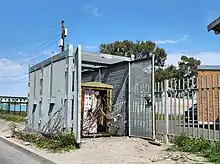Electricity theft
Electricity theft is the criminal practice of stealing electrical power. The practice of stealing electricity is nearly as old as electricity distribution. Electricity theft is accomplished via a variety of means, from methods as rudimentary as directly hooking to a power line, to manipulation of computerized electrical meters. Electricity theft is most common in developing countries where power grids deliver inadequate and unreliable power.[1] The global cost of electricity theft was estimated at $96 billion every year.[2] Some punishments for the crime include fines and incarceration. The electricity losses caused by the theft are classified as non-technical losses.

History
On March 27, 1886 it was reported that electricity espionage was accomplished by unscrupulous persons tapping into Edison Electricity in New York. The Superintendent of the power station sent a power surge into the line to burn out or destroy foreign objects trespassing on the line.[3]
Types
There are various types of electrical power theft, including Tapping a line or bypassing the energy meter. According to a study , 80% of worldwide theft occurs in private dwellings and 20% on commercial and industrial premises. The various types of electrical power theft include:
Direct hooking from line

What's known as "cable hooking" is the most used method. 80% of global power theft is by direct tapping from the line. The consumer taps into a power line from a point ahead of the energy meter. This energy consumption is unmeasured and procured with or without switches. It can cause severe electric shock or fire outbreak.
Bypassing the energy meter
In this method, the input terminal and output terminal of the energy meter is bridged, preventing the energy from registering in the energy meter.[4]
Injecting foreign element in the energy meter
Meters are manipulated via a remote by installing a circuit inside the meter so that the meter can be slowed down at any time. This kind of modification can evade external inspection attempts because the meter is always correct unless the remote is turned on.
Physical obstruction
This type of tampering is done to electromechanical meters with a rotating element. Foreign material is placed inside the meter to obstruct the free movement of the disc. A slower rotating disk signals less energy consumption.
ESD attack on electronic meter
ESD tampering is done on electronic meter to make it either latent damage or permanent damage. Detection can be done correctly in high end meters only.
Detection
A number of approaches to detect electricity theft have been proposed. The predominant direction in research and development is employing artificial intelligence, and in particular machine learning methods, to detect customers that steal electricity.[5]
By country
According to the annual Emerging Markets Smart Grid: Outlook 2015 study by the Northeast Group, LLC, the world loses US$89.3 billion annually to electricity theft. The highest losses were in India ($16.2 billion), followed by Brazil ($10.5 billion) and Russia ($5.1 billion).[6]
Brazil
Brazil is South America's largest single energy user, accounting for around 36% of total energy consumption. The incidence of energy theft is roughly 15%, and it exceeds 50% in the country's north. [7][8][9] Electricity theft cost BRL 6.5 billion (about €1.15 billion) in 2020 alone.[7][10][11]
India
President of Northeast Group Ben Gardner stated: "India loses more money to theft than any other country in the world. The state of Maharashtra—which includes Mumbai—alone loses $2.8 billion per year, more than all but eight countries in the world. Nationally, total transmission and distribution losses approach 23% and some states' losses exceed 50%."[12]
Pakistan
Turkey
In Turkey electricity theft is mainly concentrated in the Southeastern and Eastern Anatolia regions, meanwhile in the Aegean Region it has the lowest prevalence. Dicle and Van Gölü companies were the most heavily effected electricity distributors in the country. In 2020 Mardin (72.7%), Şırnak (70.9%) and Diyarbakır (65.4%) provinces have had the highest use of stolen electricity. In contrast Denizli (1.3%) have had the lowest prevalence among Turkish provinces with regard to electricity theft.[13]
The cost of the electricity theft is compensated nationally, where users in every province pay an equal amount of electricity theft tax, independent from the prevalence of theft in respective province. Since 2013 there had been efforts to regionalize the theft tax, but these were not implemented. The national tax system is planned to be continued until the end of 2025.[14]
In popular culture
Katiyabaaz (Powerless), a 2014 Indian documentary film, dealt with issue of power theft in the city of Kanpur, Uttar Pradesh.[15]
See also
- Electricity theft in Pakistan
- Metal theft of the cables that carry electricity
References
- "For utilities in developing countries, revenue collection can be challenging – and COVID-19 could be exacerbating the problem | EEG". www.energyeconomicgrowth.org. Retrieved 2022-06-03.
- LLC, Northeast Group. "$96 Billion Is Lost Every Year To Electricity Theft". www.prnewswire.com (Press release). Retrieved 2022-02-24.
- "People Who Steal Edison's Electricity". Daily Yellowstone journal. 1886-03-27. Retrieved 2016-07-09.
- Sreenivasan (2017). Power Theft. New Delhi: PHI Learning[P]Ltd. pp. 87–88. ISBN 9788120352810.
- Glauner, P.; et al. (2017). "The Challenge of Non-Technical Loss Detection using Artificial Intelligence: A Survey". International Journal of Computational Intelligence Systems. 10 (1): 760–775. arXiv:1606.00626. doi:10.2991/ijcis.2017.10.1.51. S2CID 9850103.
- LLC, Northeast Group. "World Loses $89.3 Billion to Electricity Theft Annually, $58.7 Billion in Emerging Markets". www.prnewswire.com (Press release).
- "Free electricity in favelas boosts Brazil's social inclusion". European Investment Bank. Retrieved 2023-04-24.
- Daniel (2012-08-01). "Smart grid solutions to Latin America's power theft crises". Power Technology. Retrieved 2023-04-24.
- "PUBLIC-PRIVATE-PARTNERSHIP LEGAL RESOURCE CENTER". PUBLIC-PRIVATE-PARTNERSHIP LEGAL RESOURCE CENTER. Retrieved 2023-04-24.
- Liaggou, Chryssa. "Power theft costs millions | eKathimerini.com". www.ekathimerini.com. Retrieved 2023-04-24.
- "Losses from fraud in Brazil added up to BRL 336 bi in 2021". Agência Brasil. 2022-08-04. Retrieved 2023-04-24.
- "India To Spend $21.6 Billion On Smart Grid Infrastructure By 2025". Transmission & Distribution World. 2015-02-12.
- "Türkiye'de kaçak elektrik kullanım haritası yayınlandı!". İndigo Dergisi (in Turkish). 2020-09-21. Retrieved 2021-03-03.
- "Hırsızın elektrik parasını ödeyeceğiz". www.sozcu.com.tr. 2020-10-07. Archived from the original on 2020-10-12. Retrieved 2021-03-03.
- "'Katiyabaaz': A documentary maker challenges mainstream space". The Times of India. 2014-08-23. Retrieved 2014-08-30.